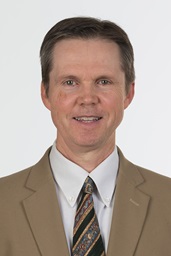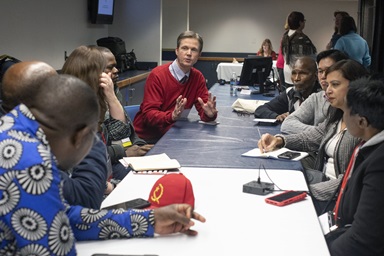Economist Donald R. House creates plan to reverse membership, financial decline in The United Methodist Church.
BRYAN, Texas (UMNS) — Can a preacher’s kid-turned-economist stop The United Methodist Church’s long numerical slide in the United States?
Donald R. House, who holds a Ph.D. in economics and chairs the South Central Jurisdiction episcopacy committee, has a plan he thinks can work.
It involves:
- Enlisting about 1,000 churches with at least 125 average attendance in worship
- Getting them to raise and spend targeted amounts on growth strategies, totaling about $120 million annually
- Moving swiftly to enroll the churches without going through an annual (regional) conference or General Conference approval process
House says his research shows that if the churches invest the amount he recommends, they will by 2021 grow enough to reverse the denomination’s downward trajectory in worship attendance in the United States.
His 34-page proposal, dense with graphs and econometrics lingo, carries the overall title “A Strategic Plan for Growth in The United Methodist Church.” House is calling the part focused on local church investment in growth “The Benchmark Project.”
The latter depends on churches raising money beyond their budgets to start or bolster programs and to hire non-clergy staff such as youth leaders or adult education directors.
“What we’re trying to do is get the local church to understand that on its own behalf and certainly for the benefit of the denomination, it has to grow, and it can only grow with investments,” House said.
House has a pilot project under way with three Texas Annual (regional) Conferencechurches. He has told each church how much it needs to spend – to the dollar – and how many new worship attendees it can expect if it does.
House has talked about his strategy with church leaders in the South Central Jurisdiction, which includes eight states stretching from Nebraska to Texas and from New Mexico to the Mississippi River. He has meetings scheduled with church agency leaders as well.
Urgency for action
House, 66, is president of RRC Inc., a Texas firm that provides expert economic testimony for litigants. His father is Morris House, a 96-year-old retired United Methodist pastor. House himself has served as a General Conference delegate and chairs the economic advisory committee of the General Council on Finance and Administration.
Last year, House led the South Central Jurisdiction episcopacy committee in trying to retire Bishop Earl Bledsoe for ineffectiveness. (The Judicial Counciloverturned the vote because of fair-process errors.)
House argued then that The United Methodist Church had lost so much U.S. membership and worship attendance that it cannot afford ineffective leaders. In touting his plan for growth, he sounds the same theme.
GCFA statistics show U.S. membership dropped from 8,071,938 in 2005 to 7,481,383 in 2011. Average weekly worship attendance went from 3,344,488 to 3,021,494 in that period.
House believes the denomination is on track to lose thousands of U.S. churches and most of the connectional structure by 2050.
“The bad news is really bad,” he said. “We have maybe six to 10 years left where we might muster the resources to turn it around.”
House’s plan draws on end-of-year reports for 32,000 churches, going back 22 years. The almost 750,000 data points enabled him to track not only membership, worship attendance and baptisms but also church budgets, shifts in the racial/ethnic composition of church neighborhoods and longevity of pastoral appointments.
House found that among similar churches, the willingness to invest in non-clergy staff and programs made a big difference in growth.
His plan calls for 998 churches to raise and spend $119.5 million a year more to address what he says are deficiencies in investment. Typically, leaders would go to the congregation, making House’s case for growth. He stressed that the churches have to add expenditures, not shift funds. And the spending has to continue, as opposed being to a one- or two-year deal.
By the third year, growth in attendance will result in enough additional giving to cover the added spending in most churches, House said.
He projects that if this investment occurs, the 998 churches will generate 53,462 more in worship attendance by 2021, enough to reverse the downward trend.
House isn’t looking for just any churches. Participants must have strong leadership (exactly who defines that is among the details yet to be worked out) and average at least 125 in worship. He said it is helpful if the church’s neighborhood reflects the racial/ethnic makeup of the congregation.
“We have not yet learned to transform a congregation very fast and to grow in the midst of a different racial composition,” he said. “We will learn that in time, but right now we don’t have the time.”
Trial run
One of the churches testing House’s plan is his own – A&M United Methodist Church in College Station, Texas, which averages about 730 in worship. House’s nine-page report for the church shows trends in attendance and spending, and notes a $67,283 annual deficiency in spending for growth.
The church plans to spend that amount to enhance its traditional worship service, adding interns in children’s and adult education programs and on advertising. House projects the church seeing 48 more people in worship by the second year.
First United Methodist in nearby Huntsville, which averages about 480 in worship, was the first to try the plan, raising $30,000 to hire a part-time parish nurse. Since October, Marjorie Bray has led community health programs, given blood pressure screenings and taken older adults to the doctor.
The Rev. Scott Dornbush said six people have started attending and joined because of Bray.
“They’ve experienced Christian compassion, and they want to be part of it,” he said.
House projects growth of 30 in worship for the church if it maintains the extra spending.
Outsider effort
House expects 20 South Central Jurisdiction churches on board by year-end and 200 by late 2014. He said he intends to expand to all jurisdictions and nearly every annual conference.
The plan also calls for raising millions in private funds to provide annual conferences and districts with better statistical data on their churches to help with pastoral appointments and other decisions.
House, who recently briefed the South Central Jurisdiction College of Bishops, wants to enlist bishops and district superintendents to help identify churches for the plan. He said his plan is meant to complement efforts such as Vital Congregations, the Healthy Church Initiative and the Path1 church starts program.
House strategy rates mixed reviews
The Rev. Jorge Acevedo, pastor of Grace (United Methodist) Church, a multisite church in southwest Florida, praised the effort behind economist Donald R. House’s “A Strategic Plan for Growth in the United Methodist Church.” However, he said. it seems overly technical and needs to be “theologized.”
The Rev. Dottie Escobedo-Frank, pastor ofCrossRoads United Methodist Church in Phoenix, said she would love for all churches to have the kind of detailed statistics House offers. She questions whether the plan would work in the West and other places where church attendance is lower than in Texas.
“It just seems a bit simple to say all we have to do is invest more dollars, and we will grow,” she said. “That might be true in some places.”
Retired Bishop Joseph E. Pennel Jr., who teaches at Vanderbilt Divinity School in Nashville, Tenn., said: “This project is about the numerical growth of The United Methodist Church, and it seems to be panic-driven though it is well-intentioned. … In my judgment, we need a serious plan for the growth of mercy, kindness, compassion, forgiveness and justice in our congregations.”
The Rev. Gary A. Shockley, who led the Path1 new church initiative for the United Methodist Board of Discipleship before becoming pastor of St. Andrew United Methodist Church in Highlands Ranch, Colo., was more upbeat.
“The infusion of funds toward crucial areas is a good idea,” he said. “Sustaining that infusion until growth supports it will be crucial.”
Learn more
Strategic Plan Proposal
Questions and Answers about plan
But House also stresses that his plan involves no apportionment dollars and must be run outside the official church.
“Strategically, I don’t think we can be effective if we’re shackled with some of these fairness issues and addressing the political issues within the formal structure of these conferences,” he said.
House hopes the Texas Methodist Foundation will manage funds and administer the plan. Tom Locke, the foundation’s president, confirmed that the foundation is considering taking on the task.
House acknowledges the need for an administrator, to avoid the appearance of conflict of interest. Should the plan catch on, his firm would be the likely candidate to do reports telling churches how much they need to raise and how much they can expect in growth.
The plan calls for churches to pay $1,250 each for a report — with extra for a presentation.
House said he has put $1.1 million into the development of the plan through paying his staff to help with research when other work was scarce, due to the recession. However, he said his motivation is not to recover the loss or generate a long-term revenue stream for RRC Inc.
“We’re not suggesting that my firm would be the one that would be doing all this work,” House said. “It’s going to be whoever is best at doing it. That’s going to be chosen by the administrator and certainly not by me.”
Bishop Cynthia Fierro Harvey of theLouisiana Annual Conference is House’s friend from Texas Conference days. House has briefed Harvey on the plan.
“What’s driving him is changing the trajectory of decline,” she said. “He’s passionate about it.”
Harvey said she is intrigued by his strategy and considering introducing it to Louisiana churches. But it will be up to them to participate.
“The only way it has legs is when the local churches take ownership,” she said.
House said his plan is a work in progress, open to revision. However, he is certain of his fundamental principle.
“If you are to make disciples, you can’t do it by shrinking. You can only do it by growing,” he said. “And you have to invest in growth.”
*Hodges, a writer for United Methodist News Service, lives in Dallas.
Like what you're reading? Support the ministry of UM News! Your support ensures the latest denominational news, dynamic stories and informative articles will continue to connect our global community. Make a tax-deductible donation at ResourceUMC.org/GiveUMCom.






